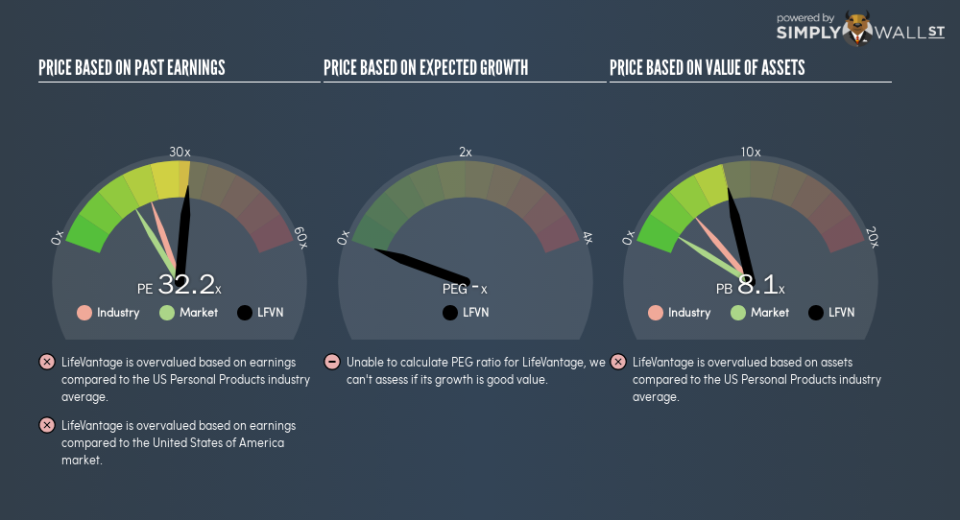Don’t Sell LifeVantage Corporation (NASDAQ:LFVN) Before You Read This

This article is for investors who would like to improve their understanding of price to earnings ratios (P/E ratios). We’ll show how you can use LifeVantage Corporation’s (NASDAQ:LFVN) P/E ratio to inform your assessment of the investment opportunity. LifeVantage has a P/E ratio of 32.18, based on the last twelve months. That corresponds to an earnings yield of approximately 3.1%.
Check out our latest analysis for LifeVantage
How Do You Calculate A P/E Ratio?
The formula for P/E is:
Price to Earnings Ratio = Share Price ÷ Earnings per Share (EPS)
Or for LifeVantage:
P/E of 32.18 = $13.46 ÷ $0.42 (Based on the year to September 2018.)
Is A High P/E Ratio Good?
A higher P/E ratio means that investors are paying a higher price for each $1 of company earnings. That isn’t a good or a bad thing on its own, but a high P/E means that buyers have a higher opinion of the business’s prospects, relative to stocks with a lower P/E.
How Growth Rates Impact P/E Ratios
When earnings fall, the ‘E’ decreases, over time. That means even if the current P/E is low, it will increase over time if the share price stays flat. Then, a higher P/E might scare off shareholders, pushing the share price down.
LifeVantage increased earnings per share by a whopping 368% last year. Unfortunately, earnings per share are down 23% a year, over 5 years.
How Does LifeVantage’s P/E Ratio Compare To Its Peers?
The P/E ratio essentially measures market expectations of a company. You can see in the image below that the average P/E (20.9) for companies in the personal products industry is lower than LifeVantage’s P/E.
That means that the market expects LifeVantage will outperform other companies in its industry. Clearly the market expects growth, but it isn’t guaranteed. So further research is always essential. I often monitor director buying and selling.
Don’t Forget: The P/E Does Not Account For Debt or Bank Deposits
Don’t forget that the P/E ratio considers market capitalization. In other words, it does not consider any debt or cash that the company may have on the balance sheet. Hypothetically, a company could reduce its future P/E ratio by spending its cash (or taking on debt) to achieve higher earnings.
Spending on growth might be good or bad a few years later, but the point is that the P/E ratio does not account for the option (or lack thereof).
LifeVantage’s Balance Sheet
Since LifeVantage holds net cash of US$12m, it can spend on growth, justifying a higher P/E ratio than otherwise.
The Verdict On LifeVantage’s P/E Ratio
LifeVantage’s P/E is 32.2 which is above average (16.5) in the US market. Its strong balance sheet gives the company plenty of resources for extra growth, and it has already proven it can grow. Therefore it seems reasonable that the market would have relatively high expectations of the company
Investors should be looking to buy stocks that the market is wrong about. If the reality for a company is better than it expects, you can make money by buying and holding for the long term. We don’t have analyst forecasts, but you could get a better understanding of its growth by checking out this more detailed historical graph of earnings, revenue and cash flow.
You might be able to find a better buy than LifeVantage. If you want a selection of possible winners, check out this free list of interesting companies that trade on a P/E below 20 (but have proven they can grow earnings).
To help readers see past the short term volatility of the financial market, we aim to bring you a long-term focused research analysis purely driven by fundamental data. Note that our analysis does not factor in the latest price-sensitive company announcements.
The author is an independent contributor and at the time of publication had no position in the stocks mentioned. For errors that warrant correction please contact the editor at editorial-team@simplywallst.com.

